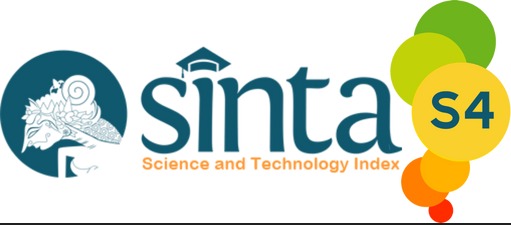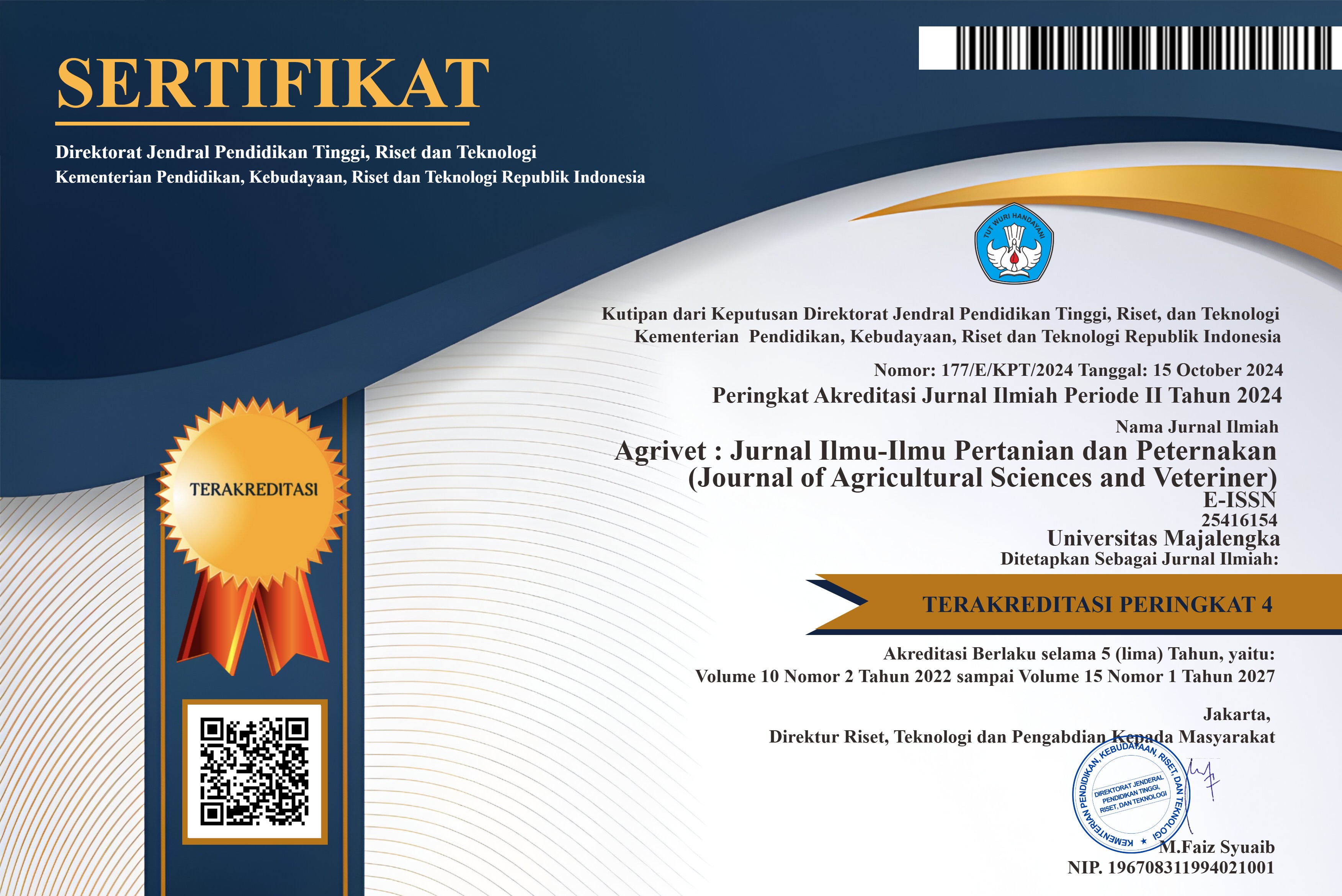Comparisons and influence temperature humidity index to dairy cow productivity based on farm altitude
DOI:
https://doi.org/10.31949/agrivet.v12i1.9458Abstract
This study aimed to determine the differences and effects of the Temperature Humidity Index (THI) on dairy cows’ productivity in West Java based on differences in farm altitude. Categorization based on area altitude can be divided into low altitude (<700 m asl), moderate (700-1000 m asl), and high (> 1,000 m asl). The parameters observed were body size, body weight, and milk production which were supplemented by environmental conditions namely temperature and humidity. The method used is a survey and direct observation by simple random sampling of animals. The results showed differences in environmental conditions, namely temperature and humidity in each dairy farm with different altitudes. Meanwhile, the performance of milk production is relatively the same even though variations in the performance of body measurements and weight of dairy cows in each region. It can be concluded that heat environmental conditions with high THI can cause cows to suffer from heat stress so that productivity decreases.
Keywords:
Altitude, Dairy Cows, Productivity, THIDownloads
References
Baumgard LH, Wheelock JB, Sanders SR, Moore CE, Green HB, Waldron MR, Rhoads RP. 2011. Postabsorptive carbohydrate adaptations to heat stress and monensin supplementation in lactating Holstein cows 1. J Dairy Sci [Internet]. 94(11):5620–5633. https://doi.org/10.3168/jds.2011-4462
Bernabucci U, Lacetera N, Baumgard LH, Rhoads RP, Ronchi B, Nardone A. 2010. Metabolic and hormonal acclimation to heat stress in domesticated ruminants. Anim Int J Anim Biosci [Internet]. 4(7):1167–1183. https://doi.org/10.1017/S175173111000090X
Collier RJ, Renquist BJ, Xiao Y. 2017. A 100-Year Review : Stress physiology including heat stress 1. J Dairy Sci [Internet]. 100(12):10367–10380. https://doi.org/10.3168/jds.2017-13676
Ensminger ME. 1971. Dairy Cattle Science. Animal Agr. Daville, Illionois.: The Interstate, Printers and Publishers, Inc.
González LA, Bryan M, Silasi R, Brown F. 2018. Factors affecting body weight loss during commercial long haul transport of cattle in North America 1. (June):3630–3639. https://doi.org/10.2527/jas2011-4786
Kadzere CT, Murphy MR, Silanikove N, Maltz E. 2002. H eat stress in lactating dairy cows : a review. 77:59–91.
Li C, Dai S, Lu J, Zhao B, Wang J, Li P, Wu Z, Mu Y, Feng C, Dong Q. 2018. Methylglyoxal: A newly detected and potentially harmful metabolite in the blood of ketotic dairy cows. J Dairy Sci [Internet]. 101(9):8513–8523. https://doi.org/10.3168/jds.2018-14448
Mader TL, Davis MS. 2014. Environmental factors influencing heat stress in feedlot cattle 1 , 2. :712–719.
Pane I. 1986. Pemuliabiakan Ternak. Jakarta: Gramedia.
St-Pierre NR. 2016. Comparison of model predictions with measurements: A novel model-assessment method. J Dairy Sci. 99(6):4907–4927. https://doi.org/10.3168/jds.2015-10032
Sudono. 1999. Ilmu Produksi Ternak Perah. Bogor: Institut Pertanian Bogor Press.
Troxel TR, Gadberry MS, Beck PA. 2016. T and emperature , relative humidity , dew point of 6 commercial trailer compartments during summer transportations of beef calves in the mid-South. Prof Anim Sci [Internet]. 32(4):461–469. https://doi.org/10.15232/pas.2015-01470
West JW, Mullinix BG, Bernard JK. 2003. Effects of Hot , Humid Weather on Milk Temperature , Dry Matter Intake , and Milk Yield of Lactating Dairy Cows. J Dairy Sci [Internet]. 86(1):232–242. https://doi.org/10.3168/jds.S0022-0302(03)73602-9
Wheelock JB, Rhoads RP, Vanbaale MJ, Sanders SR, Baumgard LH. 2010. Effects of heat stress on energetic metabolism in lactating Holstein cows 1. J Dairy Sci [Internet]. 93(2):644–655. https://doi.org/10.3168/jds.2009-2295
Whittier JC. 1993. Hot Weather Livestock Stress. Columbia: Univ. Missouri Ext.
Published
How to Cite
Issue
Section
License
Copyright (c) 2024 Bambang Kholiq Mutaqin, Didin Supriat Tasripin, Lia Budimulyati Salman, Iin Susilawati, Ujang Hidayat Tanuwiria1

This work is licensed under a Creative Commons Attribution-ShareAlike 4.0 International License.
An author who publishes in the Jurnal Agrivet agrees to the following terms:
- Author retains the copyright and grants the journal the right of first publication of the work simultaneously licensed under the Creative Commons Attribution-ShareAlike 4.0 License that allows others to share the work with an acknowledgment of the work's authorship and initial publication in this journal
- The author is able to enter into separate, additional contractual arrangements for the non-exclusive distribution of the journal's published version of the work (e.g., post it to an institutional repository or publish it in a book) with the acknowledgment of its initial publication in this journal.
- The author is permitted and encouraged to post his/her work online (e.g., in institutional repositories or on their website) prior to and during the submission process, as it can lead to productive exchanges, as well as earlier and greater citation of the published work












